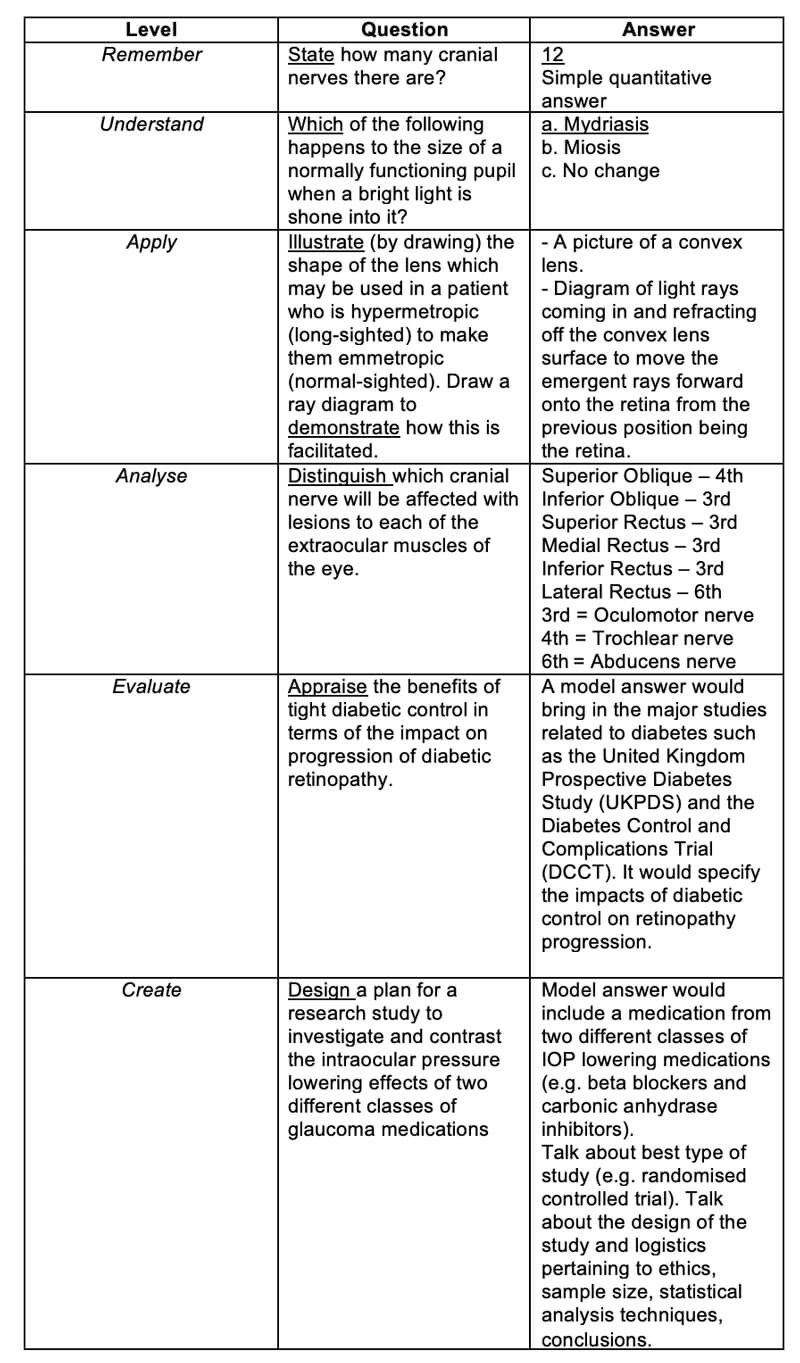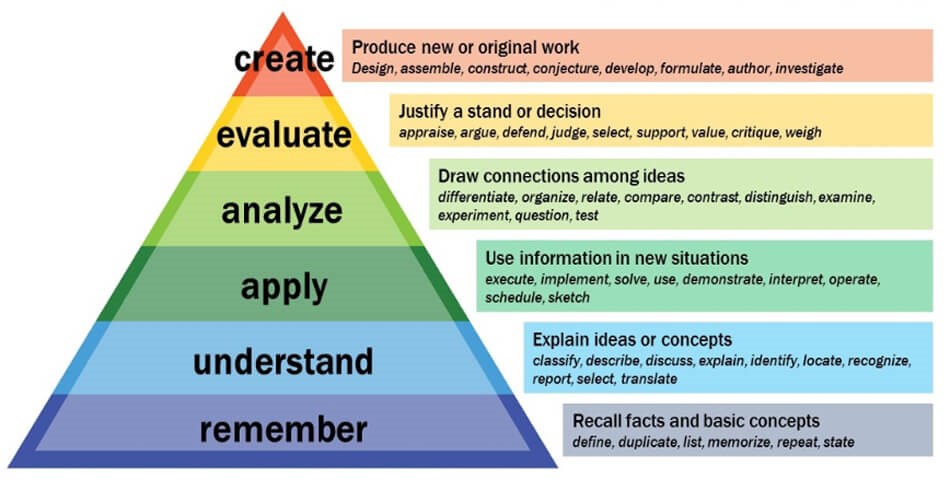
Bloom’s Taxonomy is a hierarchical list of attributes and skills that facilitates teachers to effectively teach, whilst concurrently enabling learners to effectively learn. It was first developed in 1956 by Benjamin Bloom, an educational psychologist along with a team of collaborators, who set out to categorise educational targets for learners [1].
Several decades later in 2001, the taxonomy was revised by a diverse group of educationalists into six distinct domains, each level requiring pre-requisite understanding of the level below [2]. In this article, the author discusses how the revised taxonomy may be used to develop assessment questions in ophthalmology; bringing in an example from each stage of the taxonomy.

Remember
In remember, we are essentially recalling facts and very simple basic concepts core to the essence of what is being taught. For example, when students begin to learn about the cranial nerves in their anatomy teaching, one of the first things they are taught is that there are conventionally 12 cranial nerves [3]. To recall this number, a learner does not actually need to understand anything in depth about the cranial nerves, their names, sensory / motor roots, innervation or anything entailing more than a simple recall. They can still get this answer right without the aforementioned details; hence it’s also integral to note that such recall is at the bottom of Bloom’s Taxonomy triangle illustration. As such, it could be said that it involves memorisation and rote learning. A simple statement of fact. The term ‘state’ used in the root of the question is testament to this.
Understand
The next level above remembering is understanding. For this, we have used a simple concept pertaining to the light reflex inherent in normally functioning pupils. This time, the question requires slightly more processing as the learner is required to know that with increasing light conditions, the pupils of the eye (without pathology as it’s made clear in the stem of the question) dilates (also referred to as mydriasis) [4]. In essence, this is testing whether the learner can understand the fundamental underlying idea central to the light reflex adaptation that they learn about in ophthalmic physiology. Furthermore, knowing about these simpler ‘understand’ concepts are integral to build upon further levels of engagement further up in Bloom’s Taxonomy such as applying and analysing. If we are to take this particular question and explore it further with regards to these, we could ask about the abnormalities indicated if the pupil does not respond by dilating to light – and also about where the potential sources of pathology may lie in these circumstances.
Apply
The level above understanding is applying. The questions we ask here is asking the learner to illustrate by drawing the type of lens which may be used in a far-sighted patient (otherwise referred to as hypermetropia) to correct their vision and make them normal-sighted (otherwise referred to as emmetropia). To answer this question correctly, the learner needs to remember the ray diagrams that illustrate how long-sighted patients have light rays which converge behind the retina, whilst also understanding that the lenses used in the discipline are intended to bring the rays onto the retina. Hence, with respect to application to answer this question, the learner will be able to draw a lens which is convex since intuition dictates that the shape will cause further convergence of the light rays bringing it forward from behind the retina onto it (depending obviously on the actual power of the lens – however that would be going further up into the domain of analysis and evaluation).

Figure 1: Illustration of the Revised Bloom’s Taxonomy [2].
Analyse
To further elaborate and deepen our understanding of the levels of Taxonomy on the three examples mentioned above, we can look to see how we may be able to adapt the topic in a question to fit into another category. In the first question, we asked the learners to state how many cranial nerves there are; to take this up to the higher analysis level we may be able to adapt the question by bringing in a clinically orientated scenario such as the loss of ocular motility, then asking them to distinguish which cranial nerve is most likely to be implicated [5]. The answer to this is multi-faceted, of course, as it depends on which extraocular muscle is affected. If it’s the lateral rectus it would be the 6th cranial nerve (abducens), if it’s the superior oblique it would be the 4th cranial nerve (trochlear) and any other extraocular muscle would suggest that the 3rd cranial nerve (oculomotor) has been affected.
Evaluate
The evaluation section in Bloom’s Taxonomy is towards the top of the triangle due to its increasing complexity – bringing together and integrating some of the categorisations aforementioned. Here, we bring in the example question pertaining to the evaluation of how the control of diabetes may impact on the progression of diabetic retinopathy. As stated above, a model answer would give a balanced overview of the major clinical trials which have taken place in relation to this topic (the DCCT and UKPDS being two such examples), highlighting the major results from these trials in terms of impact on microvascular complications in relation to retinopathy. It would also be expected that the populations studied (Type 1 and Type 2 Diabetes) and perhaps even the limitations of each are delved into [6].
Create
The creation category lies at the top of the taxonomy triangle. This is the most advanced level of assessment as it brings together many of the lower order domains to examine the ability to formulate and design something novel. Often, in these kind of questions, there is no specific model right answer, rather the most integral element is the reasoning and understanding which is manifested to develop an answer to such a question. Here, we have used the example of asking learners to develop a study to investigate and contrast the intraocular pressure lowering actions of medications and being able to contrast them to one another. This brings together knowledge about medications which lower intraocular pressure (e.g. Beta-adrenergic blockers, Carbonic Anhydrase Inhibitors, Prostaglandin Analogues, Alpha-adrenergic agonists etc) and the ability to design a study – which requires knowledge of the different types of studies used in investigations (e.g. randomised controlled trials, case-control trials, prospective and retrospective studies etc.) [7]. It assesses the learner’s ability to bring all of these together, taking into account associated pragmatic factors (e.g. sample size) to outline how a good study may be formulated to answer this question. Often, in the learning journey, it’s important to realise that a lot of the material that is taught to learners is ultimately to enable them to gradually reach a point where they are able to ‘create’ as that is ultimately what drives learning, research and academia forward.
References
1. Bloom BS: Taxonomy of educational objectives: The classification of educational goals. New York, NY: Longmans, Green; 1956.
2. Anderson LW, Krathwohl DR: A taxonomy for teaching, learning, and assessing: A revision of Bloom’s taxonomy of educational objectives. New York, NY: Longman; 2001.
3. Davis MC, Griessenauer CJ, Bosmia AN, et al. The naming of the cranial nerves: a historical review. Clin Anat 2014;27(1):14-9.
4. Kardon R. Pupillary light reflex. Curr Opin Ophthalmol 1995;6(6):20-6.
5. Park HK, Rha HK, Lee KJ, et al. Microsurgical anatomy of the oculomotor nerve. Clin Anat 2017;30(1):21-31.
6. Higgins GT, Khan J, Pearce IA. Glycaemic control and control of risk factors in diabetes patients in an ophthalmology clinic: what lessons have we learned from the UKPDS and DCCT studies? Acta Ophthalmol Scand 2007;85(7):772-6.
7. Guglielmi P, Carradori S, Campestre C, Poce G. Novel therapies for glaucoma: a patent review (2013-2019). Expert Opin Ther Pat 2019;29(10):769-80.
COMMENTS ARE WELCOME






